界门纲目科属种共30页
界属纲门目种科
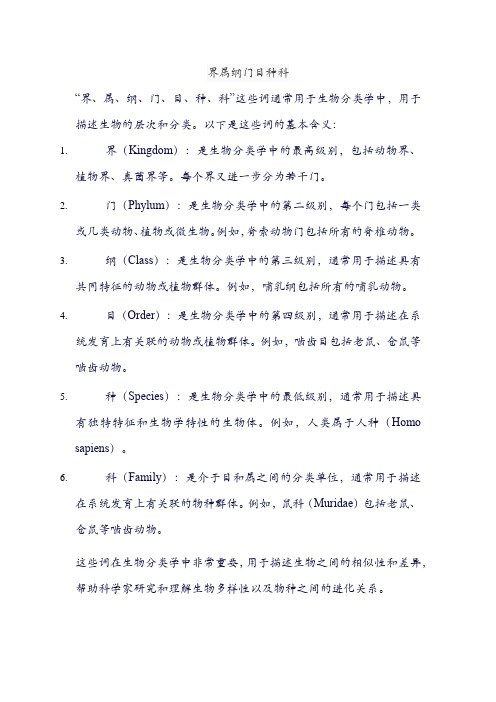
界属纲门目种科
“界、属、纲、门、目、种、科”这些词通常用于生物分类学中,用于描述生物的层次和分类。
以下是这些词的基本含义:
1.界(Kingdom):是生物分类学中的最高级别,包括动物界、
植物界、真菌界等。
每个界又进一步分为若干门。
2.门(Phylum):是生物分类学中的第二级别,每个门包括一类
或几类动物、植物或微生物。
例如,脊索动物门包括所有的脊椎动物。
3.纲(Class):是生物分类学中的第三级别,通常用于描述具有
共同特征的动物或植物群体。
例如,哺乳纲包括所有的哺乳动物。
4.目(Order):是生物分类学中的第四级别,通常用于描述在系
统发育上有关联的动物或植物群体。
例如,啮齿目包括老鼠、仓鼠等啮齿动物。
5.种(Species):是生物分类学中的最低级别,通常用于描述具
有独特特征和生物学特性的生物体。
例如,人类属于人种(Homo sapiens)。
6.科(Family):是介于目和属之间的分类单位,通常用于描述
在系统发育上有关联的物种群体。
例如,鼠科(Muridae)包括老鼠、仓鼠等啮齿动物。
这些词在生物分类学中非常重要,用于描述生物之间的相似性和差异,帮助科学家研究和理解生物多样性以及物种之间的进化关系。
种属科目纲门界例子
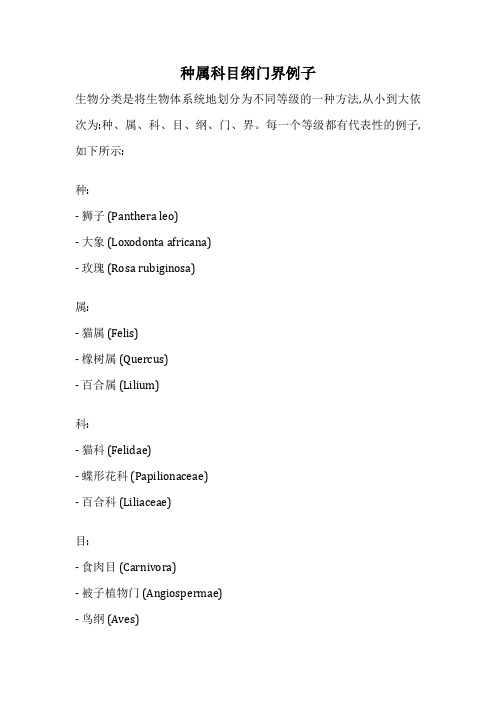
种属科目纲门界例子
生物分类是将生物体系统地划分为不同等级的一种方法,从小到大依次为:种、属、科、目、纲、门、界。
每一个等级都有代表性的例子,如下所示:
种:
- 狮子 (Panthera leo)
- 大象 (Loxodonta africana)
- 玫瑰 (Rosa rubiginosa)
属:
- 猫属 (Felis)
- 橡树属 (Quercus)
- 百合属 (Lilium)
科:
- 猫科 (Felidae)
- 蝶形花科 (Papilionaceae)
- 百合科 (Liliaceae)
目:
- 食肉目 (Carnivora)
- 被子植物门 (Angiospermae)
- 鸟纲 (Aves)
纲:
- 哺乳纲 (Mammalia)
- 昆虫纲 (Insecta)
- 藻类门 (Algae)
门:
- 动物门 (Animalia)
- 植物门 (Plantae)
- 真菌门 (Fungi)
界:
- 原核生物界 (Prokaryotae)
- 真核生物界 (Eukaryotae)
- 古细菌界 (Archaea)
通过这些层层递进的分类等级,我们可以更好地理解和研究生物的亲缘关系和进化历程。
界门纲目科属种分类依据
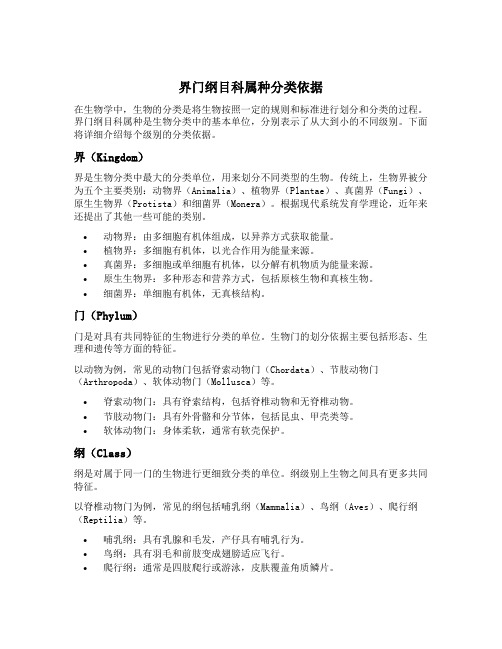
界门纲目科属种分类依据在生物学中,生物的分类是将生物按照一定的规则和标准进行划分和分类的过程。
界门纲目科属种是生物分类中的基本单位,分别表示了从大到小的不同级别。
下面将详细介绍每个级别的分类依据。
界(Kingdom)界是生物分类中最大的分类单位,用来划分不同类型的生物。
传统上,生物界被分为五个主要类别:动物界(Animalia)、植物界(Plantae)、真菌界(Fungi)、原生生物界(Protista)和细菌界(Monera)。
根据现代系统发育学理论,近年来还提出了其他一些可能的类别。
•动物界:由多细胞有机体组成,以异养方式获取能量。
•植物界:多细胞有机体,以光合作用为能量来源。
•真菌界:多细胞或单细胞有机体,以分解有机物质为能量来源。
•原生生物界:多种形态和营养方式,包括原核生物和真核生物。
•细菌界:单细胞有机体,无真核结构。
门(Phylum)门是对具有共同特征的生物进行分类的单位。
生物门的划分依据主要包括形态、生理和遗传等方面的特征。
以动物为例,常见的动物门包括脊索动物门(Chordata)、节肢动物门(Arthropoda)、软体动物门(Mollusca)等。
•脊索动物门:具有脊索结构,包括脊椎动物和无脊椎动物。
•节肢动物门:具有外骨骼和分节体,包括昆虫、甲壳类等。
•软体动物门:身体柔软,通常有软壳保护。
纲(Class)纲是对属于同一门的生物进行更细致分类的单位。
纲级别上生物之间具有更多共同特征。
以脊椎动物门为例,常见的纲包括哺乳纲(Mammalia)、鸟纲(Aves)、爬行纲(Reptilia)等。
•哺乳纲:具有乳腺和毛发,产仔具有哺乳行为。
•鸟纲:具有羽毛和前肢变成翅膀适应飞行。
•爬行纲:通常是四肢爬行或游泳,皮肤覆盖角质鳞片。
目(Order)目是对属于同一纲的生物进行更具体分类的单位。
目级别上生物之间具有更为明显的共同特征。
以哺乳纲为例,常见的目包括食肉目(Carnivora)、鳞翅目(Lepidoptera)、啮齿目(Rodentia)等。
生物有界门纲目科属种七级

生物有界门纲目科属种七级
生物的基本分类层次:界、门、纲、目、科、属、种。
生物的详细分类层次:域、界、门、亚门、总纲、纲、亚纲、总目、目、亚目、总科、科、亚科、总属、属、亚属、总种、种、亚种。
种是最小的生物单位。
生物的相同科、目越多,共同点也越多。
域是生物分类法中最高的类别。
作为比界高的分类系统,称作“域”(Domain)或者“总界”(Superkingdom)。
目前这三域分别命名为细菌域(Bacteria)﹑古菌域(Archaea)和真核域(Eukarya)。
生物由原核生物、真核生物及非细胞生物组成,包括动物、植物、细菌、真菌、病毒等,其特征是可以进行新陈代谢。
分类组成植物藻类植物、苔癣、蕨类植物、种子植物动物脊椎动物哺乳动物、两栖动物、鸟类、鱼类、爬行动物无脊椎动物节肢动物、腔肠动物、棘皮动物、线形动物、扁形动物、原生动物、环节动物、软体动物微生物真菌、细菌、支原体、衣原体、立克次体、螺旋体、放线菌、病毒三域系统生物分类。
真核域动物界、真菌界、变形虫界、植物界、有孔虫
界细菌域原核生物界古菌域嗜泉古菌界、广域古菌界、初生古菌界。
(完整版)常见微生物的界、门、纲、目、科、属、种中英文对照
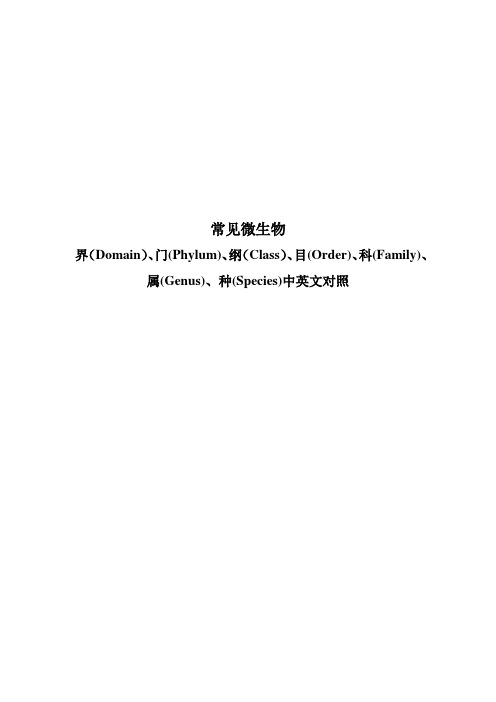
常见微生物界(Domain)、门(Phylum)、纲(Class)、目(Order)、科(Family)、属(Genus)、种(Species)中英文对照界(Domain)Bacteria细菌Archaea古生菌门(Phylum)Proteobacteria 变形菌门Bacteroidetes 拟杆菌门Actinobacteria 放线菌门Gemmatimonadetes 芽单胞菌门Acidobacteria 酸杆菌门Planctomycetes 浮霉菌门Verrucomicrobia 疣微菌门Chloroflexi 绿弯菌门Nitrospirae 硝化螺旋菌门Firmicutes 厚壁菌门Chlorobi 绿菌门Cyanobacteria 蓝藻细菌门Fibrobacteres 纤维杆菌门Elusimicrobia 迷踪菌门Armatimonadetes 装甲菌门Euryarchaeota 广古菌门Chlamydiae 衣原体Crenarchaeota 泉古菌门Tenericutes 无壁菌门Spirochaetes 螺旋体属Alphaproteobacteria 甲型(α)变形杆菌纲Gammaproteobacteria 丙型变形菌纲Betaproteobacteria β-变形菌纲Actinobacteria 放线菌门、纲Cytophagia 纤维粘网菌Gemmatimonadetes 芽单胞菌门、纲Deltaproteobacteria δ-变形菌纲Acidobacteria-6 酸杆菌门Acidimicrobiia 酸微菌纲Verrucomicrobiae 疣微菌纲Opitutae 丰佑菌纲Nitrospira 消化螺菌属Thermomicrobia 热微菌门Bacteroidia 拟杆菌纲Bacilli 杆菌Chloroflexi 绿弯菌门Anaerolineae 厌氧绳菌纲Clostridia 梭状芽胞杆菌Elusimicrobia 迷踪菌门Ktedonobacteria 纤线杆菌纲Thermoplasmata 热原体纲Chlamydiia 衣原体Thaumarchaeota 奇古菌门Mollicutes 柔膜菌纲Methanomicrobia 甲烷微菌纲Holophagae 全噬菌纲Spirochaetes 螺旋体属Xanthomonadales 黄单孢菌目Sphingomonadales 鞘脂单胞菌目Burkholderiales 伯克霍尔德氏菌目Actinomycetales 放线菌目Cytophagales 噬纤维菌目Myxococcales 粘球菌目Acidimicrobiales 酸微菌目Rhizobiales 根瘤菌目Sphingobacteriales 鞘脂杆菌目Flavobacteriales 黄杆菌目Caulobacterales 柄杆菌目Rhodospirillales 红螺菌目Alteromonadales 交替单胞菌目Enterobacteriales 肠杆菌目Verrucomicrobiales 疣微菌目Opitutales 丰佑菌目Gemmatimonadales 芽单胞菌目Nitrospirales 硝化螺旋菌目Pseudomonadales 假单胞菌目Planctomycetales 浮霉菌目Bacteroidales 拟杆菌目Syntrophobacterales 互营杆菌目Bacillales 芽孢杆菌目Thiotrichales 硫发菌目Rhodobacterales 红细菌目,红杆菌目Methylophilales 噬甲基菌目Nitrosomonadales 亚硝化单胞菌目Streptophyta 木霉菌目Clostridiales 梭菌目Legionellales 军团菌目Bdellovibrionales 蛭弧菌目Rubrobacterales 红色杆菌目Caldilineales 暖绳菌目Herpetosiphonales 爬管菌目Chloroflexales 绿弯菌目Rickettsiales 立克次氏体目Acidobacteriales 酸杆菌目Micrococcales 微球菌目Rhodocyclales 红环菌目Stramenopiles 不等鞭毛类Chlamydiales 衣原体目Ktedonobacterales 纤线杆菌目Neisseriales 奈瑟菌目Oceanospirillales 海洋螺菌目Anaeroplasmatales 厌氧原体目Natranaerobiales 盐碱厌氧菌目Halanaerobiales 盐碱厌氧菌目Procabacteriales 普罗卡杆菌目Sphaerobacterales 球杆菌目Methylococcales 甲基球菌目Chlorophyta 绿藻门Holophagales 全噬菌目Methanosarcinales 八叠球菌目,球菌目Bifidobacteriales 双歧杆菌目Methanomicrobiales 甲烷微菌目Aeromonadales 气单胞菌目Spirochaetales 螺旋体目Desulfuromonadales 除硫单胞菌目科(family)Sphingomonadaceae 鞘脂单胞菌科Xanthomonadaceae 黄单胞菌科Cytophagaceae 噬纤维菌科Oxalobacteraceae 草酸杆菌科Nocardioidaceae 类诺卡氏菌科Comamonadaceae 丛毛单胞菌科Caulobacteraceae 柄杆菌科Sphingobacteriaceae 鞘脂杆菌科Flavobacteriaceae 黄杆菌科Sinobacteraceae 华杆菌科Rhodospirillaceae 红螺旋菌科Hyphomicrobiaceae 生丝微菌科Polyangiaceae 多囊粘菌科Erythrobacteraceae 赤杆菌科Enterobacteriaceae 肠杆菌科Verrucomicrobiaceae 疣微菌科Geodermatophilaceae 地嗜皮菌科Opitutaceae 丰佑菌科Streptomycetaceae 链霉菌科Alteromonadaceae 交替单胞菌科Micrococcaceae 微球菌科Actinosynnemataceae 束丝防线菌科Micromonosporaceae 微单胞菌科Pseudomonadaceae 假单胞菌科Planctomycetaceae 浮霉菌科Nannocystaceae 侏囊菌科Syntrophobacteraceae 互营杆菌科Sporichthyaceae 鱼孢菌科Streptosporangiaceae 链孢囊菌科Bradyrhizobiaceae 慢生根瘤菌科Piscirickettsiaceae 鱼立克次体科Rhizobiaceae 根瘤菌科Microbacteriaceae 微杆菌科Pseudonocardiaceae 假诺卡氏科Bacillaceae 芽孢杆菌科Intrasporangiaceae 间孢囊菌科Nitrospiraceae 硝化螺旋菌科Methylophilaceae 噬甲基菌科Phyllobacteriaceae 叶杆菌科,叶瘤菌科Alcaligenaceae 产碱菌科,产碱杆菌科Nitrosomonadaceae 亚硝化单胞菌科Rhodobacteraceae 红杆菌科Thermomonosporaceae 高温单胞菌科Glycomycetaceae 糖霉菌科Acetobacteraceae 醋杆菌科Mycobacteriaceae 分支杆菌科Hyphomonadaceae 生丝单胞菌科Rubrobacteraceae 红色杆菌科Cystobacteraceae 孢囊杆菌科Caldilineaceae 暖绳菌科Rhodobiaceae 红菌科,红游动菌科Burkholderiaceae 伯克氏菌科Coxiellaceae 柯克斯体科Bdellovibrionaceae 蛭弧菌科Acidobacteriaceae 酸杆菌科Clostridiaceae 梭菌科Paenibacillaceae 类芽孢杆菌科Bacteriovoracaceae 噬菌弧菌科Myxococcaceae 粘液球菌科Cellulomonadaceae 纤维素单胞菌科Beijerinckiaceae 拜叶林克氏菌科Frankiaceae 弗兰克氏菌科Rhodocyclaceae 红环菌科Planococcaceae 动球菌科Methylocystaceae 甲基孢囊菌科Nocardiaceae 诺卡式菌科Chloroflexaceae 绿屈挠菌科Thermoactinomycetaceae 高温放线菌科Staphylococcaceae 葡萄球菌科Alicyclobacillaceae 环脂酸芽孢杆菌科Nocardiopsaceae 拟诺卡式菌科Legionellaceae 军团菌科Ktedonobacteraceae 纤线杆菌科Gemmatimonadaceae 芽单胞菌科Moraxellaceae 莫拉氏菌科Corynebacteriaceae 棒状杆菌科Parachlamydiaceae 副衣原体科Cystobacterineae 孢囊杆菌亚目Aurantimonadaceae 橙单胞菌科Bogoriellaceae 博格利亚湖菌科Methylobacteriaceae 甲基杆菌科Rickettsiaceae 立克次氏体Brucellaceae 布鲁氏菌科Lachnospiraceae 毛螺菌科Neisseriaceae 奈瑟氏菌科Halomonadaceae 盐单胞菌科Anaeroplasmataceae 厌氧原体科Peptococcaceae 消化球菌科,冻球菌科Halanaerobiaceae 盐厌氧菌科Peptostreptococcaceae 消化链球菌科Dermabacteraceae 皮杆菌科Procabacteriaceae 普洛卡杆菌科Kineosporiaceae 动孢囊菌科Methylococcaceae 甲基球菌科Syntrophomonadaceae 单胞菌科,互营单胞菌科Oscillochloridaceae 颤绿菌科Chlamydomonadaceae 【植物】衣藻科Holosporaceae 全胞菌科Gordoniaceae 戈登氏菌科Shewanellaceae 希万氏菌科Aeromonadaceae 气单胞菌科Geobacteraceae 地杆菌科Brevibacteriaceae 短杆菌科Porphyromonadaceae 紫单胞菌科Xanthobacteraceae 黄色杆菌科Spirochaetaceae 螺旋体科Propionibacteriaceae 丙酸杆菌科属(Genus)Janthinobacterium 紫色杆菌属Flavobacterium 黄杆菌属Thermomonas 热单胞菌属Mycoplana 枝动杆菌属Sorangium 堆囊菌属Opitutus 丰佑菌属Sphingomonas 鞘脂单胞菌属Streptomyces 链霉菌属Lysobacter 溶杆菌属Cellvibrio 纤维弧菌属Pedobacter 地杆菌属Aeromicrobium 气微菌属Rhodoplanes 红游动菌属Pseudomonas 假单胞菌属Planctomyces 浮霉状菌属Phenylobacterium 苯基杆菌属Pseudoxanthomonas 假黄色单胞菌属Sphingobium 鞘脂菌属Nannocystis 侏囊菌属Variovorax 贪噬菌属Luteimonas 单胞菌属Gemmata 出芽菌属Saccharothrix 糖丝菌属Prosthecobacter 突柄杆菌属Pirellula 小梨型菌属Acidovorax 食酸菌属Lentzea 伦茨氏菌属Streptosporangium 链孢子囊菌属Caulobacter 茎菌属Nocardioides 类诺卡氏菌属Stenotrophomonas 寡养单胞菌Nitrosovibrio 弧菌属Actinoplanes 游动放线菌属Rubrivivax 红肠命菌属Glycomyces 糖霉菌属Agrobacterium 土壤杆菌属Mesorhizobium 中慢生根瘤菌属Agromyces 壤霉菌属Mycobacterium 分枝杆菌属Chondromyces 粒杆粘细菌属Novosphingobium 新鞘氨醇菌属Actinomadura 马杜拉放线菌属Nonomuraea 野野村菌属Catellatospora 链孢菌属Geodermatophilus 地嗜皮菌属Nitrospira 硝化螺菌属Pseudonocardia 假诺卡氏菌属Sporocytophaga 生孢噬胞菌属Bdellovibrio 蛭弧菌属Asticcacaulis 不粘杆菌属Sinorhizobium 中华根瘤菌Hydrogenophaga 噬氢菌属Rubrobacter 红色杆菌属Dactylosporangium 指孢囊菌属Sphingobacterium 鞘氨醇杆菌属Brevundimonas 短波单胞菌属Burkholderia 伯克霍尔德菌Achromobacter 无色杆菌属Hyphomicrobium 生丝微菌属Pedomicrobium 土微菌属Paenibacillus 类芽孢杆菌Phyllobacterium 叶杆菌属Cellulomonas 纤维菌属Pilimelia 水生角质菌属Arthrobacter 节细菌属Saccharopolyspora 糖多孢菌属Myxococcus 粘球菌Amycolatopsis 拟无枝酸菌Phaeospirillum 褐螺菌属Promicromonospora 原小单孢菌属Cellulosimicrobium 纤维菌属Sporichthya 游鱼孢菌属Chloronema 绿线菌属Nocardia 诺卡氏菌属Pimelobacter 脂肪杆菌属Paracoccus 副球菌属Bosea 氏菌属Staphylococcus 葡萄球菌属Planomicrobium 动性微菌属Rhodoferax 红育菌属Rhodobacter 红杆菌属Hymenobacter 薄层菌属Saccharomonospora 糖单胞菌属Cytophaga 噬细胞菌属Ralstonia 罗尔斯通菌属Rathayibacter 拉氏杆菌属Gemmatimonas 芽单胞菌属Alicyclobacillus 杆菌属Clostridium 梭菌属Corynebacterium 棒状杆菌属Cupriavidus 贪铜菌属Caldilinea 暖绳菌属Azorhizophilus 嗜氮根瘤菌属Rhodococcus 红球菌属Legionella 军团杆菌Brevibacillus 短芽孢杆菌属Polaromonas 单胞菌属Acinetobacter 不动杆菌属Georgenia 乔治菌属Actinocorallia 珊瑚状防线菌属Cryptosporangium 隐孢菌属Comamonas 丛毛单胞菌属CandidatusProtochlamydia Asteroleplasma 无甾醇原体属Sporosarcina 芽孢八叠球菌属Azospirillum 固氮螺菌属Magnetospirillum 磁螺菌属Roseomonas 玫瑰单胞菌属Prauserella 氏菌属Coprococcus 粪球菌属Prauseria 布劳氏菌属Thermoactinomyces 高温防线菌属Methylobacterium 甲基杆菌属Brachybacterium 短状杆菌属Azoarcus 固氮弧菌属Beijerinckia 拜叶林克氏菌属Virgibacillus 枝芽孢菌属Syntrophomonas 互营单胞菌属Geobacillus 土芽孢杆菌属Parachlamydia 副衣原体属Anaeromyxobacter 厌氧粘细菌属Oscillochloris 颤绿菌属Procabacter 普罗卡杆菌属Methanosarcina 甲烷八叠球菌属Microbacterium 微杆菌属Methylophaga 噬甲基菌属Methanoculleus 甲烷囊菌属Methylocaldum 甲基暖菌属Rickettsia 立克次氏体Alkaliphilus 嗜碱菌属Cryobacterium 冷杆菌属Shewanella 希瓦氏菌属Gordonia 戈登氏菌属Psychrobacter 嗜冷杆菌属Serratia 沙雷氏菌属Spirochaeta 螺旋体属Leptolyngbya 鞘丝藻属Caloramator 喜热菌属Dietzia 迪茨氏属Hyphomonas 生丝单胞菌属Yersinia 耶尔森氏鼠疫杆菌属Microlunatus 小月菌属Anaerolinea 厌氧绳菌属Brevibacterium 短杆菌属。
人教版生物七年级上册2.4.2《从种到界》课件(共30张PPT)

苹果在植物分类中的位置
界 植物界
门 种子植物门
(被子植物亚门)
纲 双子叶植物纲
目 蔷薇目
科 蔷薇科
属 苹果属 种 苹果
分类单位的特点
生物等级
界 门 纲目科属种
大
小
生物种类 多
少
共同特征 少
多
亲缘关系 远
近
分类单位越大,包含的生物种类越多,所包含生物的共同特征越少, 亲缘关系越远。
比较苹果、桃和银杏在植物分类中的位置,判断它们的亲缘关系
( √) ( ×)
( √) ( √)
2. 在界、门、纲、目、科、属、种这7个等级的分类单位中,你认为哪 个等级的生物共同特征最多?哪个最少?说出你的理由。
同一种内生物的共同特征最多,同一界内的共同特征最少。
练习与应用
二、拓展应用 蝙蝠会飞,但在分类学上属于哺乳纲,而不属于鸟纲,请
你说出其中的原因。
课堂小结
生物分类的等级
界、门、纲、目、科、属、种
同种生物的共同特征最多
生物分类的规律 同种生物之间的亲缘关系最近
从 种
同界生物包含的物种最多
到 界 种是最基本的分类单位
“品种”不是分类单位
物种之间有明确的界限,存在生殖隔离
生物命名
双名法(林奈):属名 + 种加词 + 命名人
分类意义
弄清不同种群间的亲缘关系和进化关系
所有的人都是同一物种。 无论是白种人、黑种人,还 是黄种人,互相结婚,都能产生 具有生殖能力的后代。
种是最基本的分类单位
关于“种”的辨析 “种”和我们平时所说的“品种”是一样的吗?
不同“品种”的狗属 于同一物种。
红富士 红将军 嘎啦苹果 澳洲青苹 红星(蛇果) 金冠
界,门,纲,目,科,属,种

动物界(真核总界):腔肠动物门:
水螅虫纲:
钵水母纲:
珊瑚虫纲:
扁型动物门:
涡虫纲:
吸虫纲:
绦虫纲:
环节动物门:
多毛纲:
贫毛纲:
蛭纲:
软体动物门:
腹足纲:
双经纲:
斧足纲:
掘足纲:
头足纲:
节肢动物门:甲壳纲:
倍足纲:
唇足纲:
蛛型纲:
六足纲:
切口纲:
棘皮动物门:海星纲:
蛇尾纲:
海胆纲:
海噀纲:
海百合纲:脊椎动物门:软骨鱼纲:硬骨鱼纲:两生纲:
爬虫纲:
鸟纲:
哺乳纲:
线型动物门:
线虫纲:
线形纲:
棘头纲:
;腹毛纲:
动吻纲:
轮虫纲:
原生动物门:
鞭毛虫纲:
肉足虫纲:
纤毛虫纲:
孢子虫纲:
植物界(真核总界):裸藻植物门:
金褐藻植物门:
甲藻植物门:
苔藓植物门:蕨类植物门:裸子植物门:被子植物门:裸藻门:
绿藻门:
轮藻门:
金藻门:
甲藻门:
褐藻门:
红藻门:
蓝藻门:
地衣门:
细菌界(原核总界):
病毒界(非细胞生物总界):粘菌门:
鞭毛菌亚门:
接合菌亚门:
子囊菌亚门:
担子菌亚门:
半知菌亚门:
真菌界(真核总界):海绵动物门:
石灰海绵纲:
六放海绵纲:
寻常海绵纲:。
界门纲目科属种怎么理解

界门纲目科属种怎么理解
界门纲目科属种,生物分类学是研究生物分类的方法和原理的生物学分支,分类就是遵循分类学原理和方法,对生物的各种类群进行命名和等级划分界门]纲目科属的定义是利用生物的外观、生活特性、构造、生理机能等特徵的差别,以二分法的方式,将生物由大分类归纳到小分类。
两界分类系统:瑞典生物学家林亲(1707~1778),把整个生物分成相应的两大类:植物界和动物界。
三界分类系统:植物界和动物界,以及原生生物界,包括细菌、藻类、真菌和原生动物。
四界分类系统:另立了1个真菌界,即原生生物界、真菌界、植物界和动物界。
五界分类系统:五界系统按复杂性增加三E个层次排列生命:原
核的单细胞(原核生物界);真核的单细胞(原生生物界);真核的多细
胞(植物界、真菌界和动物界),即原核生物界、原生生物界、植物界、菌物界、动物界。
两总界五界分类系统:去掉原生生物界而成为两总界五界分类系统:原核总界(分为细菌界和蓝藻界)和真核总界(分为植物界、真菌界和动物界);原来属于原生生物界的生物,依情况分属到植物界、真菌界和动物界。
界门纲目科属种
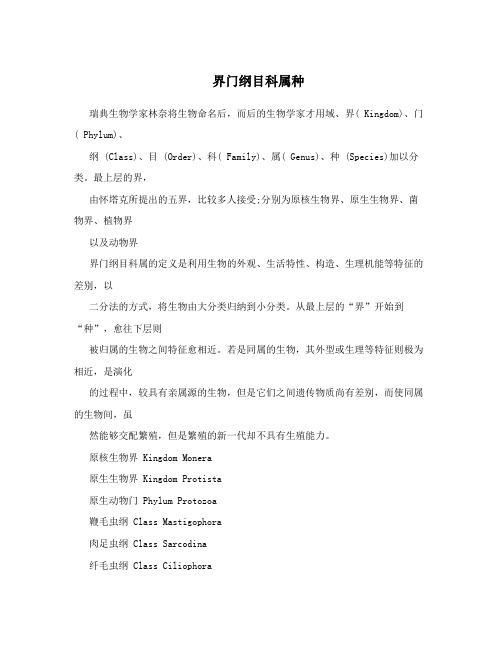
界门纲目科属种瑞典生物学家林奈将生物命名后,而后的生物学家才用域、界( Kingdom)、门( Phylum)、纲 (Class)、目 (Order)、科( Family)、属( Genus)、种 (Species)加以分类。
最上层的界,由怀塔克所提出的五界,比较多人接受;分别为原核生物界、原生生物界、菌物界、植物界以及动物界界门纲目科属的定义是利用生物的外观、生活特性、构造、生理机能等特征的差别,以二分法的方式,将生物由大分类归纳到小分类。
从最上层的“界”开始到“种”,愈往下层则被归属的生物之间特征愈相近。
若是同属的生物,其外型或生理等特征则极为相近,是演化的过程中,较具有亲属源的生物,但是它们之间遗传物质尚有差别,而使同属的生物间,虽然能够交配繁殖,但是繁殖的新一代却不具有生殖能力。
原核生物界 Kingdom Monera原生生物界 Kingdom Protista原生动物门 Phylum Protozoa鞭毛虫纲 Class Mastigophora肉足虫纲 Class Sarcodina纤毛虫纲 Class Ciliophora孢子虫纲 Class Sporozoa裸藻植物门 Phylum Euglenophyta 金褐藻植物门 Phylum Chrysophyta 甲藻植物门 Phylum Pyrrophyta真菌界 Kingdom Fungi植物界 Kingdom Plantae裸藻门Euglenophyta绿藻门Chlorophyta轮藻门Charophyta金藻门Chrysophyta甲藻门Pyrrophyta褐藻门Phaeophyta红藻门Rhodophyta蓝藻门Cyanophyta细菌门Bacteriophyta粘菌门Myxomycophyta真菌门Eumycophyta地衣门Lichens苔藓植物门Bryophyta蕨类植物门Pteridophyta裸子植物门Gymnospermae被子植物门Angiospermae动物界 Kingdom Animalia海绵动物门 Phylum Polifera石灰海绵纲 Class Calcarea六放海绵纲 Class Hexactinellida 寻常海绵纲 Class Demospongiae腔肠动物门 Phylum Coelenterata水螅虫纲 Class Hydrozoa钵水母纲 Class Scyphzoa珊瑚虫纲 Class Anthozoa扁型动物门 Phylum Platyhelminthes 涡虫纲 Class Turbellaria吸虫纲 Class Trematoda绦虫纲 Class Cestoda圆型动物门 Phylum Nematoda环节动物门 Phylum Annelida多毛纲 Class Polychaeta贫毛纲 Class Oligochaeta蛭纲 Class Hirudinea软体动物门 Phylum Mollusca腹足纲 Class Gastropoda双经纲 Class Amphineura斧足纲 Class Pelecypoda掘足纲 Class Scaphopoda头足纲 Class Cephalopoda节肢动物门 Phylum Arthorpoda甲壳纲 Class Crustacea倍足纲 Class Diplopoda唇足纲 Class Chilopoda蛛型纲 Class Archnida六足纲 Class Hexapoda切口纲 Class Merostomat 棘皮动物门 Phylum Echinodermata海星纲 Class Asteroidea蛇尾纲 Class Ophiuroidea海胆纲 Class Echinoidea海噀纲 Class Holothuroidea海百合纲 Class Crinoidea脊索动物门 Phylum Chordata头索动物亚门 Subphylum Cephalochordata尾索动物亚门 Subphylum Urochordata脊椎动物亚门 Subphylum Vertebrata软骨鱼纲 Class Chondrichthyes硬骨鱼纲 Class Osteichthyes两生纲 Class Amphibia爬虫纲 Class Reptilia鸟纲 Class Aves哺乳纲 Class Mammalia--------------------------------------------界门纲目科属种的分类来历:近代分类学诞生于18世纪,它的奠基人是瑞典植物学者林奈。
界,门,纲,目,科,属,种
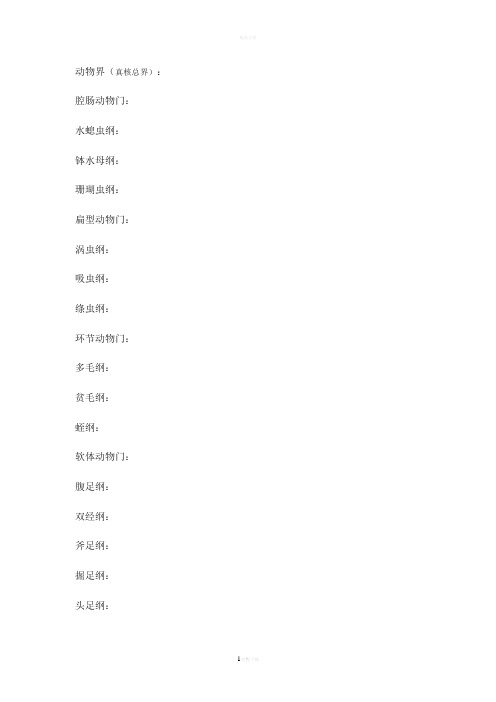
动物界(真核总界):腔肠动物门:
水螅虫纲:
钵水母纲:
珊瑚虫纲:
扁型动物门:
涡虫纲:
吸虫纲:
绦虫纲:
环节动物门:
多毛纲:
贫毛纲:
蛭纲:
软体动物门:
腹足纲:
双经纲:
斧足纲:
掘足纲:
头足纲:
节肢动物门:甲壳纲:
倍足纲:
唇足纲:
蛛型纲:
六足纲:
切口纲:
棘皮动物门:海星纲:
蛇尾纲:
海胆纲:
海噀纲:
海百合纲:脊椎动物门:软骨鱼纲:硬骨鱼纲:两生纲:
爬虫纲:
鸟纲:
哺乳纲:
线型动物门:
线虫纲:
线形纲:
棘头纲:
;腹毛纲:
动吻纲:
轮虫纲:
原生动物门:
鞭毛虫纲:
肉足虫纲:
纤毛虫纲:
孢子虫纲:
植物界(真核总界):裸藻植物门:
金褐藻植物门:
甲藻植物门:
苔藓植物门:蕨类植物门:裸子植物门:被子植物门:裸藻门:
绿藻门:
轮藻门:
金藻门:
甲藻门:
褐藻门:
红藻门:
蓝藻门:
地衣门:
细菌界(原核总界):
病毒界(非细胞生物总界):粘菌门:
鞭毛菌亚门:
接合菌亚门:
子囊菌亚门:
担子菌亚门:
半知菌亚门:
真菌界(真核总界):海绵动物门:
石灰海绵纲:
六放海绵纲:
寻常海绵纲:
欢迎您的下载,
资料仅供参考!
致力为企业和个人提供合同协议,策划案计划书,学习资料等等
打造全网一站式需求。
界,门,纲,目,科,属,种

界,门,纲,目,科,属,种
动物界(真核总界):腔肠动物门:
水螅虫纲:
钵水母纲:
珊瑚虫纲:
扁型动物门:
涡虫纲:
吸虫纲:
绦虫纲:
环节动物门:
多毛纲:
贫毛纲:
蛭纲:
软体动物门:
腹足纲:
双经纲:
斧足纲:
掘足纲:
头足纲:
哺乳纲:
线型动物门:
线虫纲:
线形纲:
棘头纲:
;腹毛纲:
动吻纲:
轮虫纲:
原生动物门:
鞭毛虫纲:
肉足虫纲:
纤毛虫纲:
孢子虫纲:
植物界(真核总界):裸藻植物门:
金褐藻植物门:
甲藻植物门:
苔藓植物门:蕨类植物门:裸子植物门:被子植物门:裸藻门:
绿藻门:
轮藻门:
金藻门:
甲藻门:
褐藻门:
红藻门:
蓝藻门:
地衣门:
细菌界(原核总界):
病毒界(非细胞生物总界):粘菌门:
鞭毛菌亚门:
接合菌亚门:
子囊菌亚门:
担子菌亚门:
半知菌亚门:
真菌界(真核总界):海绵动物门:
石灰海绵纲:
六放海绵纲:
寻常海绵纲:。
所有的界门纲目科属种生物分类分为:界、门、纲、目、科、属、种最具体...

所有的界门纲目科属种生物分类分为:界、门、纲、目、科、属、种最具体...你要的是什么的?植物还是动物?很多!自己在植物学和动物学的书上找吧。
你回找得到那你想要的1 藻类植物(Algae)1.1 蓝藻门(Cyanophyta)蓝藻纲(Cyanophyceae)l 色球藻目(Chroococcales)l 管胞藻目(Chamaesiphonales)l 颤藻目(Osillatoriales)1.2 裸藻门 (Euglenophyta)裸藻纲 (Euglenophyceae)l 裸藻目(Euglenales)l 柄裸藻目(Colaciales)1.3 金藻门 (Chrysophyta)金藻纲 (Chrysophyceae)l 金胞藻目(Chrysomonadales)l 根金藻目(Rhizochrysidales)l 金囊藻目(Chrysocapsales)l 金球藻目(Chrysosphaerales)l 金枝藻目(Phaeothamniales)1.4 甲藻门 (Pyrrophyta)纵裂甲藻纲(Desmophyceae)l 原甲藻目(Prorocentrales)横裂甲藻纲(Dinophyceae)l 多甲藻目(Peridi-niales)l 变形甲藻目(Dinamoebidiales)l 胶甲藻目(Gloeodiniales)l 球甲藻目(Dinococcales)1.5 黄藻门(Xanthophyta) (Chromophyta) 黄藻纲 (Xanthophyceae)l 异鞭藻目(Heterochloridales)l 根黄藻目(Rhizochloridales)l 异囊藻目(Heteroglocales)l 柄球藻目(Mischococcales)l 异丝藻目(Heterotrichales)l 气球藻目(Botrydiales)1.6 硅藻门 (Bacillariophyta)中心硅藻纲l 圆筛藻目l 根管藻目l 盒形藻目羽纹硅藻纲l 无壳藻目l 单壳藻目l 短壳藻目l 双壳藻目l 管壳藻目1.7 绿藻门(Chlorophyta)绿藻纲(Chlorophyceae)l 团藻目(Volvocales)l 四胞藻目(Tetrasporales)l 色球藻目(Chlorococcales)l 丝藻目(Ulotrichales)l 胶毛藻目(Chaetophorales)l 石莼目(Ulvales)l 溪菜目(Prasiolales)l 鞘藻目(Oedogoniales)l 管藻目(Siphonales)l 管枝藻目(Siphonocladales)l 绒枝藻目(Dasycladales)l 双星藻目(Zygnematales)1.8 轮藻门 (Charophyta)轮藻纲(Charophyceae)l 轮藻目1.9 褐藻门 (phaeophyta)等世代纲不等世代纲无孢子纲1.10 红藻门 (Rhodophyta)红藻纲l 紫菜亚纲l 真红藻亚纲2 地衣植物门(Lichenes)l 子囊衣纲(Ascolichens)l 担子衣纲(Basidiolichens)l 半知衣纲(Deuterolichens)3 苔藓植物门(Bryophyta)3.1 苔纲(Hepaticae)l 藻苔目l 地钱目l 美苔目l 囊果苔目l 叶苔目3.2 藓纲(Musci)l 泥炭藓亚纲(Sphagnidae)l 黑藓亚纲(Asdreaeidae)l 真藓亚纲(Bryidae)3.3 角苔纲(Anthocerotae)4 蕨类植物门 (Pteridophyta)4.1 石松亚门 (Lycophytina)石松纲 Lycopsida4.2 水韭亚门 (Isoephytina)水韭纲 Isoetinae水韭目 Isoetales水韭科 Isoetaceae水韭属 Isoetes spp.4.3 楔叶蕨亚门(Sphenophytina)楔叶蕨纲 (Sphenopsida)木贼目 (Equisetales)木贼科 (Equisetaceae)木贼属 (Equisetum)4.4 裸蕨亚门 (Psilophytina)裸蕨纲 Psilopsida松叶蕨目 Psilotales松叶蕨科 Psilotaceae4.5 真蕨亚门 (Filicophytina)l 厚囊蕨纲 (Eusporangiopsida)l 原始薄囊蕨纲 (Protolyptosporangiopsida) l 薄囊蕨纲 (Leptosporangiopsida)5 种子植物门(Spemaiophyla)5.1 裸子植物亚门 Gymnospermae5.1.1 银杏纲 (Ginkgopsida)·银杏目 Ginkgoaleso 银杏科 Ginkgoaceae&, lt;, SPAN lang=EN-US style="FONT-SIZE: 10pt; FONT-FAMILY: Wingdings; mso-bidi-font-size: 13.5pt; mso-fareast-language: ZH">§ 银杏属 Ginkgo§ 银杏 Ginkgo biloba5.1.2 松柏纲 (Coniferopsida)l 科达目(已绝种)l 伏脂杉目(已绝种)l 松柏目 (Coniferales)5.1.3 苏铁纲 (Gycadopsida)l 种子蕨目 (Pteridospermae)(已绝种)l 开通目 (Caytoniales)(已绝种)l 本内苏铁目 (Bennettitales)(已绝种)l 苏铁目(Cycabales)5.1.4 买麻藤纲 (Gnetopsida)l 买麻藤目 (Gnetales)l 麻黄目 (Ephedrales)l 百岁兰目 (Welwitschiales)5.1.5 红豆杉纲(Taxopsida)l 红豆杉目 Taxales5.2 被子植物亚门(木兰门)Angiospermae或Magnoliophyta或flowering plants5.2.1 单子叶植物纲(百合纲) Liliopsida5.2.1.1 百合亚纲 Liliidae百合目 Lilialesl 百合科 Liliaceae蒜属:蒜,洋葱,韭菜l 风信子科 Hyacinthaceae风信子属 Hyacinthus :风信子 Hyacinth l 田葱科 Philydraceael 龙舌兰科 Agavaceael 鸢尾科 Iridaceael 百部科 Stemonaceael 菝葜科 Smilacaceael 薯蓣科 Dioscoreaceael 蒟蒻薯科 Taccaceae兰目 Orchidalesl 兰科 Orchidaceael 水玉簪科 Burmanniaceae5.2.1.2 泽泻亚纲 Alismatidae泽泻目 Alismatales水鳖目 Hydrocharitales茨藻目 Najadales霉草目 Triuridales5.2.1.3 槟榔亚纲 Arecidae槟榔目 Arecales环花草目 Cyclanthales露兜树目 Pandanales天南星目 Aralesl 天南星科 Araceael 浮萍科 Lemnaceae5.2.1.4 鸭跖草亚纲 Commelinidae鸭跖草目 Commelinales谷精草目 Eriocaulales帚灯草目 Restionales灯心草目 Juncales莎草目 Cyperalesl 禾本科 Poaceae竹 Bambool 莎草科 Cyperaceae香蒲目 Typhales5.2.1.5 姜亚纲 Zingiberidae姜目 Zingiberalesl 美人蕉科 Cannaceael 闭鞘姜科 Costaceael 赫蕉科 Heliconiaceae,蝎尾蕉科。
界门纲目科属种[终稿]
![界门纲目科属种[终稿]](https://img.taocdn.com/s3/m/33a546d5d4bbfd0a79563c1ec5da50e2524dd12b.png)
界门纲目科属种瑞典生物学家林奈将生物命名后,而后的生物学家才用域、界( Kingdom)、门( Phylum)、纲 (Class)、目 (Order)、科( Family)、属( Genus)、种 (Species)加以分类。
最上层的界,由怀塔克所提出的五界,比较多人接受;分别为原核生物界、原生生物界、菌物界、植物界以及动物界界门纲目科属的定义是利用生物的外观、生活特性、构造、生理机能等特征的差别,以二分法的方式,将生物由大分类归纳到小分类。
从最上层的“界”开始到“种”,愈往下层则被归属的生物之间特征愈相近。
若是同属的生物,其外型或生理等特征则极为相近,是演化的过程中,较具有亲属源的生物,但是它们之间遗传物质尚有差别,而使同属的生物间,虽然能够交配繁殖,但是繁殖的新一代却不具有生殖能力。
原核生物界 Kingdom Monera原生生物界 Kingdom Protista原生动物门 Phylum Protozoa鞭毛虫纲 Class Mastigophora肉足虫纲 Class Sarcodina纤毛虫纲 Class Ciliophora孢子虫纲 Class Sporozoa裸藻植物门 Phylum Euglenophyta金褐藻植物门 Phylum Chrysophyta甲藻植物门 Phylum Pyrrophyta真菌界 Kingdom Fungi植物界 Kingdom Plantae裸藻门Euglenophyta绿藻门Chlorophyta轮藻门Charophyta金藻门Chrysophyta甲藻门Pyrrophyta褐藻门Phaeophyta红藻门Rhodophyta蓝藻门Cyanophyta细菌门Bacteriophyta粘菌门Myxomycophyta真菌门Eumycophyta地衣门Lichens苔藓植物门Bryophyta蕨类植物门Pteridophyta裸子植物门Gymnospermae被子植物门Angiospermae动物界 Kingdom Animalia海绵动物门 Phylum Polifera石灰海绵纲 Class Calcarea六放海绵纲 Class Hexactinellida 寻常海绵纲 Class Demospongiae腔肠动物门 Phylum Coelenterata水螅虫纲 Class Hydrozoa钵水母纲 Class Scyphzoa珊瑚虫纲 Class Anthozoa扁型动物门 Phylum Platyhelminthes 涡虫纲 Class Turbellaria吸虫纲 Class Trematoda绦虫纲 Class Cestoda圆型动物门 Phylum Nematoda环节动物门 Phylum Annelida多毛纲 Class Polychaeta贫毛纲 Class Oligochaeta蛭纲 Class Hirudinea软体动物门 Phylum Mollusca腹足纲 Class Gastropoda双经纲 Class Amphineura斧足纲 Class Pelecypoda掘足纲 Class Scaphopoda头足纲 Class Cephalopoda节肢动物门 Phylum Arthorpoda甲壳纲 Class Crustacea倍足纲 Class Diplopoda唇足纲 Class Chilopoda蛛型纲 Class Archnida六足纲 Class Hexapoda切口纲 Class Merostomata棘皮动物门 Phylum Echinodermata海星纲 Class Asteroidea蛇尾纲 Class Ophiuroidea海胆纲 Class Echinoidea海噀纲 Class Holothuroidea海百合纲 Class Crinoidea脊索动物门 Phylum Chordata头索动物亚门 Subphylum Cephalochordata尾索动物亚门 Subphylum Urochordata脊椎动物亚门 Subphylum Vertebrata软骨鱼纲 Class Chondrichthyes硬骨鱼纲 Class Osteichthyes两生纲 Class Amphibia爬虫纲 Class Reptilia鸟纲 Class Aves哺乳纲 Class Mammalia--------------------------------------------界门纲目科属种的分类来历:近代分类学诞生于18世纪,它的奠基人是瑞典植物学者林奈。
界、门、纲、目、科、属、种的分类

被子植物门的特征
种子植物门的一类,具有花、果实和种子等生殖器官,以种子繁殖后代。 植物体一般由根、茎、叶、花、果实和种子等器官组成,形态多样。 被子植物门的植物通常有发达的纤维细胞,能够形成支持组织,使植物体直立。 被子植物门的植物在生长过程中,通常会形成木质部和韧皮部,以运输水分和养分。
黏菌门的特征
黏菌门是真菌界 的一门,与其他 真菌不同的是, 黏菌门的生物没 有细胞壁,因此 具有柔软的质地。
黏菌门的生物通 常在湿润的环境 中生长,例如在 腐烂的植物或动 物尸体上,它们 通过吸收营养来 生存。
黏菌门的生物在 繁殖时,会通过 产生孢子的方式 进行无性繁殖, 孢子可以随风飘 散,从而传播到 其他地方。
生态学研究:生物分类学可以帮助生态学家了解不同物种之间的相互关系,以及它们 在生态系统中的作用。
生物资源利用:通过生物分类学,可以更好地了解和利用生物资源,包括药用植物、 农作物和微生物等。
生物进化研究:生物分类学可以帮助我们更好地了解生物进化的历程和机制,从而更 好地理解生命的本质和起源。
生物多样性的保护和利用
哺乳纲动物具有高 度发达的繁殖和育 幼行为,能够提供 良好的生存环境和 营养物质,保证后 代的健康成长。
哺乳纲动物具有复 杂的社群行为和社 会结构,能够通过 各种方式进行交流 和协作,以适应不 同的生存环境。
双子叶植物纲的特征
种子植物门的一纲,又称木兰纲。
花部通常为5或4基数,偶有3基数 或6基数。
种的分类特点:种是最基本的分类单位,同一物种下的生物能够进行自然 繁殖并产生可育后代,具有相同的遗传特征和形态特征。
目、科、属、种的命名规则
目的命名通常以该类生物的某一显著特征或习性来命名,例如“蜻蜓目” 中的“蜻蜓”就是以该类生物的飞行方式来命名的。
生物学分类(门-科)整理
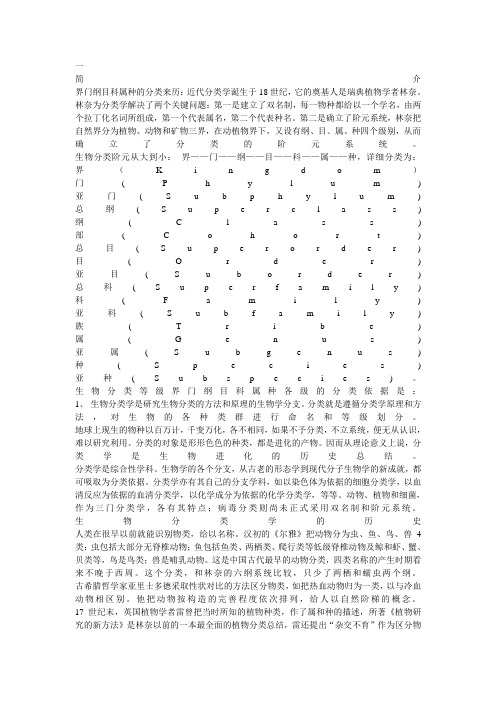
一简介界门纲目科属种的分类来历:近代分类学诞生于18世纪,它的奠基人是瑞典植物学者林奈。
林奈为分类学解决了两个关键问题:第一是建立了双名制,每一物种都给以一个学名,由两个拉丁化名词所组成,第一个代表属名,第二个代表种名。
第二是确立了阶元系统,林奈把自然界分为植物、动物和矿物三界,在动植物界下,又设有纲、目、属、种四个级别,从而确立了分类的阶元系统。
生物分类阶元从大到小:界——门——纲——目——科——属——种,详细分类为:界(K i n g d o m)门(P h y l u m) 亚门(S u b p h y l u m) 总纲(S u p e r c l a s s) 纲(C l a s s) 部(C o h o r t) 总目(S u p e r o r d e r) 目(O r d e r) 亚目(S u b o r d e r) 总科(S u p e r f a m i l y) 科(F a m i l y) 亚科(S u b f a m i l y) 族(T r i b e) 属(G e n u s) 亚属(S u b g e n u s) 种(S p e c i e s) 亚种(S u b s p e c i e s)。
生物分类等级界门纲目科属种各级的分类依据是:1、生物分类学是研究生物分类的方法和原理的生物学分支。
分类就是遵循分类学原理和方法,对生物的各种类群进行命名和等级划分。
地球上现生的物种以百万计,千变万化,各不相同,如果不予分类,不立系统,便无从认识,难以研究利用。
分类的对象是形形色色的种类,都是进化的产物。
因而从理论意义上说,分类学是生物进化的历史总结。
分类学是综合性学科。
生物学的各个分支,从古老的形态学到现代分子生物学的新成就,都可吸取为分类依据。
分类学亦有其自己的分支学科,如以染色体为依据的细胞分类学,以血清反应为依据的血清分类学,以化学成分为依据的化学分类学,等等。
常见微生物的界、门、纲、目、科、属、种中英文对照

常见微生物的界、门、纲、目、科、属、种中英文对照(总17页)-CAL-FENGHAI.-(YICAI)-Company One1-CAL-本页仅作为文档封面,使用请直接删除常见微生物界(Domain)、门(Phylum)、纲(Class)、目(Order)、科(Family)、属(Genus)、种(Species)中英文对照界(Domain)Bacteria细菌Archaea古生菌门(Phylum)Proteobacteria 变形菌门Bacteroidetes 拟杆菌门Actinobacteria 放线菌门Gemmatimonadetes 芽单胞菌门Acidobacteria 酸杆菌门Planctomycetes 浮霉菌门Verrucomicrobia 疣微菌门Chloroflexi 绿弯菌门Nitrospirae 硝化螺旋菌门Firmicutes 厚壁菌门Chlorobi 绿菌门Cyanobacteria 蓝藻细菌门Fibrobacteres 纤维杆菌门Elusimicrobia 迷踪菌门Armatimonadetes 装甲菌门Euryarchaeota 广古菌门Chlamydiae 衣原体Crenarchaeota 泉古菌门Tenericutes 无壁菌门Spirochaetes 螺旋体属纲(Class)Alphaproteobacteria 甲型(α)变形杆菌纲Gammaproteobacteria 丙型变形菌纲Betaproteobacteria β-变形菌纲Actinobacteria 放线菌门、纲Cytophagia 纤维粘网菌Gemmatimonadetes 芽单胞菌门、纲Deltaproteobacteria δ-变形菌纲Acidobacteria-6 酸杆菌门Acidimicrobiia 酸微菌纲Verrucomicrobiae 疣微菌纲Opitutae 丰佑菌纲Nitrospira 消化螺菌属Thermomicrobia 热微菌门Bacteroidia 拟杆菌纲Bacilli 杆菌Chloroflexi 绿弯菌门Anaerolineae 厌氧绳菌纲Clostridia 梭状芽胞杆菌Elusimicrobia 迷踪菌门Ktedonobacteria 纤线杆菌纲Thermoplasmata 热原体纲Chlamydiia 衣原体Thaumarchaeota 奇古菌门Mollicutes 柔膜菌纲Methanomicrobia 甲烷微菌纲Holophagae 全噬菌纲Spirochaetes 螺旋体属目(Order)Xanthomonadales 黄单孢菌目Sphingomonadales 鞘脂单胞菌目Burkholderiales 伯克霍尔德氏菌目Actinomycetales 放线菌目Cytophagales 噬纤维菌目Myxococcales 粘球菌目Acidimicrobiales 酸微菌目Rhizobiales 根瘤菌目Sphingobacteriales 鞘脂杆菌目Flavobacteriales 黄杆菌目Caulobacterales 柄杆菌目Rhodospirillales 红螺菌目Alteromonadales 交替单胞菌目Enterobacteriales 肠杆菌目Verrucomicrobiales 疣微菌目Opitutales 丰佑菌目Gemmatimonadales 芽单胞菌目Nitrospirales 硝化螺旋菌目Pseudomonadales 假单胞菌目Planctomycetales 浮霉菌目Bacteroidales 拟杆菌目Syntrophobacterales 互营杆菌目Bacillales 芽孢杆菌目Thiotrichales 硫发菌目Rhodobacterales 红细菌目,红杆菌目Methylophilales 噬甲基菌目Nitrosomonadales 亚硝化单胞菌目Streptophyta 木霉菌目Clostridiales 梭菌目Legionellales 军团菌目Bdellovibrionales 蛭弧菌目Rubrobacterales 红色杆菌目Caldilineales 暖绳菌目Herpetosiphonales 爬管菌目Chloroflexales 绿弯菌目Rickettsiales 立克次氏体目Acidobacteriales 酸杆菌目Micrococcales 微球菌目Rhodocyclales 红环菌目Stramenopiles 不等鞭毛类Chlamydiales 衣原体目Ktedonobacterales 纤线杆菌目Neisseriales 奈瑟菌目Oceanospirillales 海洋螺菌目Anaeroplasmatales 厌氧原体目Natranaerobiales 盐碱厌氧菌目Halanaerobiales 盐碱厌氧菌目Procabacteriales 普罗卡杆菌目Sphaerobacterales 球杆菌目Methylococcales 甲基球菌目Chlorophyta 绿藻门Holophagales 全噬菌目Methanosarcinales 八叠球菌目,球菌目Bifidobacteriales 双歧杆菌目Methanomicrobiales 甲烷微菌目Aeromonadales 气单胞菌目Spirochaetales 螺旋体目Desulfuromonadales 除硫单胞菌目科(family)Sphingomonadaceae 鞘脂单胞菌科Xanthomonadaceae 黄单胞菌科Cytophagaceae 噬纤维菌科Oxalobacteraceae 草酸杆菌科Nocardioidaceae 类诺卡氏菌科Comamonadaceae 丛毛单胞菌科Caulobacteraceae 柄杆菌科Sphingobacteriaceae 鞘脂杆菌科Flavobacteriaceae 黄杆菌科Sinobacteraceae 华杆菌科Rhodospirillaceae 红螺旋菌科Hyphomicrobiaceae 生丝微菌科Polyangiaceae 多囊粘菌科Erythrobacteraceae 赤杆菌科Enterobacteriaceae 肠杆菌科Verrucomicrobiaceae 疣微菌科Geodermatophilaceae 地嗜皮菌科Opitutaceae 丰佑菌科Streptomycetaceae 链霉菌科Alteromonadaceae 交替单胞菌科Micrococcaceae 微球菌科Actinosynnemataceae 束丝防线菌科Micromonosporaceae 微单胞菌科Pseudomonadaceae 假单胞菌科Planctomycetaceae 浮霉菌科Nannocystaceae 侏囊菌科Syntrophobacteraceae 互营杆菌科Sporichthyaceae 鱼孢菌科Streptosporangiaceae 链孢囊菌科Bradyrhizobiaceae 慢生根瘤菌科Piscirickettsiaceae 鱼立克次体科Rhizobiaceae 根瘤菌科Microbacteriaceae 微杆菌科Pseudonocardiaceae 假诺卡氏科Bacillaceae 芽孢杆菌科Intrasporangiaceae 间孢囊菌科Nitrospiraceae 硝化螺旋菌科Methylophilaceae 噬甲基菌科Phyllobacteriaceae 叶杆菌科,叶瘤菌科Alcaligenaceae 产碱菌科,产碱杆菌科Nitrosomonadaceae 亚硝化单胞菌科Rhodobacteraceae 红杆菌科Thermomonosporaceae 高温单胞菌科Glycomycetaceae 糖霉菌科Acetobacteraceae 醋杆菌科Mycobacteriaceae 分支杆菌科Hyphomonadaceae 生丝单胞菌科Rubrobacteraceae 红色杆菌科Cystobacteraceae 孢囊杆菌科Caldilineaceae 暖绳菌科Rhodobiaceae 红菌科,红游动菌科Burkholderiaceae 伯克氏菌科Coxiellaceae 柯克斯体科Bdellovibrionaceae 蛭弧菌科Acidobacteriaceae 酸杆菌科Clostridiaceae 梭菌科Paenibacillaceae 类芽孢杆菌科Bacteriovoracaceae 噬菌弧菌科Myxococcaceae 粘液球菌科Cellulomonadaceae 纤维素单胞菌科Beijerinckiaceae 拜叶林克氏菌科Frankiaceae 弗兰克氏菌科Rhodocyclaceae 红环菌科Planococcaceae 动球菌科Methylocystaceae 甲基孢囊菌科Nocardiaceae 诺卡式菌科Chloroflexaceae 绿屈挠菌科Thermoactinomycetaceae 高温放线菌科Staphylococcaceae 葡萄球菌科Alicyclobacillaceae 环脂酸芽孢杆菌科Nocardiopsaceae 拟诺卡式菌科Legionellaceae 军团菌科Ktedonobacteraceae 纤线杆菌科Gemmatimonadaceae 芽单胞菌科Moraxellaceae 莫拉氏菌科Corynebacteriaceae 棒状杆菌科Parachlamydiaceae 副衣原体科Cystobacterineae 孢囊杆菌亚目Aurantimonadaceae 橙单胞菌科Bogoriellaceae 博格利亚湖菌科Methylobacteriaceae 甲基杆菌科Rickettsiaceae 立克次氏体Brucellaceae 布鲁氏菌科Lachnospiraceae 毛螺菌科Neisseriaceae 奈瑟氏菌科Halomonadaceae 盐单胞菌科Anaeroplasmataceae 厌氧原体科Peptococcaceae 消化球菌科,冻球菌科Halanaerobiaceae 盐厌氧菌科Peptostreptococcaceae 消化链球菌科Dermabacteraceae 皮杆菌科Procabacteriaceae 普洛卡杆菌科Kineosporiaceae 动孢囊菌科Methylococcaceae 甲基球菌科Syntrophomonadaceae 单胞菌科,互营单胞菌科Oscillochloridaceae 颤绿菌科Chlamydomonadaceae 【植物】衣藻科Holosporaceae 全胞菌科Gordoniaceae 戈登氏菌科Shewanellaceae 希万氏菌科Aeromonadaceae 气单胞菌科Geobacteraceae 地杆菌科Brevibacteriaceae 短杆菌科Porphyromonadaceae 紫单胞菌科Xanthobacteraceae 黄色杆菌科Spirochaetaceae 螺旋体科Propionibacteriaceae 丙酸杆菌科属(Genus)Janthinobacterium 紫色杆菌属Flavobacterium 黄杆菌属Thermomonas 热单胞菌属Mycoplana 枝动杆菌属Sorangium 堆囊菌属Opitutus 丰佑菌属Sphingomonas 鞘脂单胞菌属Streptomyces 链霉菌属Lysobacter 溶杆菌属Cellvibrio 纤维弧菌属Pedobacter 地杆菌属Aeromicrobium 气微菌属Rhodoplanes 红游动菌属Pseudomonas 假单胞菌属Planctomyces 浮霉状菌属Phenylobacterium 苯基杆菌属Pseudoxanthomonas 假黄色单胞菌属Sphingobium 鞘脂菌属Nannocystis 侏囊菌属Variovorax 贪噬菌属Luteimonas 单胞菌属Gemmata 出芽菌属Saccharothrix 糖丝菌属Prosthecobacter 突柄杆菌属Pirellula 小梨型菌属Acidovorax 食酸菌属Lentzea 伦茨氏菌属Streptosporangium 链孢子囊菌属Caulobacter 茎菌属Nocardioides 类诺卡氏菌属Stenotrophomonas 寡养单胞菌Nitrosovibrio 弧菌属Actinoplanes 游动放线菌属Rubrivivax 红肠命菌属Glycomyces 糖霉菌属Agrobacterium 土壤杆菌属Mesorhizobium 中慢生根瘤菌属Agromyces 壤霉菌属Mycobacterium 分枝杆菌属Chondromyces 粒杆粘细菌属Novosphingobium 新鞘氨醇菌属Actinomadura 马杜拉放线菌属Nonomuraea 野野村菌属Catellatospora 链孢菌属Geodermatophilus 地嗜皮菌属Nitrospira 硝化螺菌属Pseudonocardia 假诺卡氏菌属Sporocytophaga 生孢噬胞菌属Bdellovibrio 蛭弧菌属Asticcacaulis 不粘杆菌属Sinorhizobium 中华根瘤菌Hydrogenophaga 噬氢菌属Rubrobacter 红色杆菌属Dactylosporangium 指孢囊菌属Sphingobacterium 鞘氨醇杆菌属Brevundimonas 短波单胞菌属Burkholderia 伯克霍尔德菌Achromobacter 无色杆菌属Hyphomicrobium 生丝微菌属Pedomicrobium 土微菌属Paenibacillus 类芽孢杆菌Phyllobacterium 叶杆菌属Cellulomonas 纤维菌属Pilimelia 水生角质菌属Arthrobacter 节细菌属Saccharopolyspora 糖多孢菌属Myxococcus 粘球菌Amycolatopsis 拟无枝酸菌Phaeospirillum 褐螺菌属Promicromonospora 原小单孢菌属Cellulosimicrobium 纤维菌属Sporichthya 游鱼孢菌属Chloronema 绿线菌属Nocardia 诺卡氏菌属Pimelobacter 脂肪杆菌属Paracoccus 副球菌属Bosea 氏菌属Staphylococcus 葡萄球菌属Planomicrobium 动性微菌属Rhodoferax 红育菌属Rhodobacter 红杆菌属Hymenobacter 薄层菌属Saccharomonospora 糖单胞菌属Cytophaga 噬细胞菌属Ralstonia 罗尔斯通菌属Rathayibacter 拉氏杆菌属Gemmatimonas 芽单胞菌属Alicyclobacillus 杆菌属Clostridium 梭菌属Corynebacterium 棒状杆菌属Cupriavidus 贪铜菌属Caldilinea 暖绳菌属Azorhizophilus 嗜氮根瘤菌属Rhodococcus 红球菌属Legionella 军团杆菌Brevibacillus 短芽孢杆菌属Polaromonas 单胞菌属Acinetobacter 不动杆菌属Georgenia 乔治菌属Actinocorallia 珊瑚状防线菌属Cryptosporangium 隐孢菌属Comamonas 丛毛单胞菌属CandidatusProtochlamydia Asteroleplasma 无甾醇原体属Sporosarcina 芽孢八叠球菌属Azospirillum 固氮螺菌属Magnetospirillum 磁螺菌属Roseomonas 玫瑰单胞菌属Prauserella 氏菌属Coprococcus 粪球菌属Prauseria 布劳氏菌属Thermoactinomyces 高温防线菌属Methylobacterium 甲基杆菌属Brachybacterium 短状杆菌属Azoarcus 固氮弧菌属Beijerinckia 拜叶林克氏菌属Virgibacillus 枝芽孢菌属Syntrophomonas 互营单胞菌属Geobacillus 土芽孢杆菌属Parachlamydia 副衣原体属Anaeromyxobacter 厌氧粘细菌属Oscillochloris 颤绿菌属Procabacter 普罗卡杆菌属Methanosarcina 甲烷八叠球菌属Microbacterium 微杆菌属Methylophaga 噬甲基菌属Methanoculleus 甲烷囊菌属Methylocaldum 甲基暖菌属Rickettsia 立克次氏体Alkaliphilus 嗜碱菌属Cryobacterium 冷杆菌属Shewanella 希瓦氏菌属Gordonia 戈登氏菌属Psychrobacter 嗜冷杆菌属Serratia 沙雷氏菌属Spirochaeta 螺旋体属Leptolyngbya 鞘丝藻属Caloramator 喜热菌属Dietzia 迪茨氏属Hyphomonas 生丝单胞菌属Yersinia 耶尔森氏鼠疫杆菌属Microlunatus 小月菌属Anaerolinea 厌氧绳菌属Brevibacterium 短杆菌属。
界门纲目科属种(Thegateofaclass)
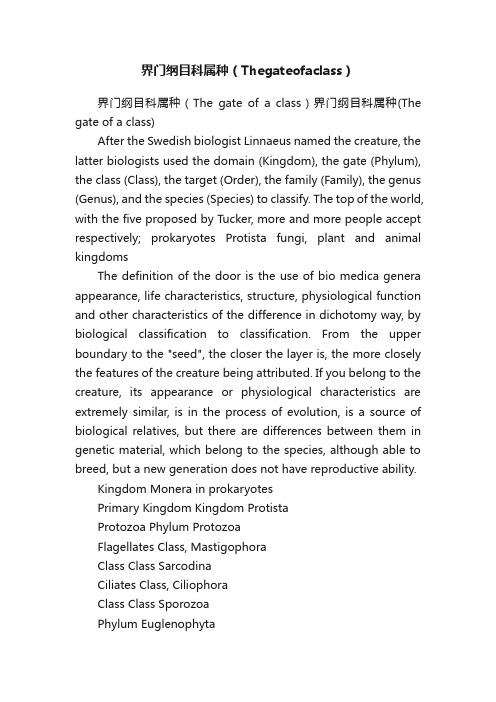
界门纲目科属种(Thegateofaclass)界门纲目科属种(The gate of a class)界门纲目科属种(The gate of a class)After the Swedish biologist Linnaeus named the creature, the latter biologists used the domain (Kingdom), the gate (Phylum), the class (Class), the target (Order), the family (Family), the genus (Genus), and the species (Species) to classify. The top of the world, with the five proposed by Tucker, more and more people accept respectively; prokaryotes Protista fungi, plant and animal kingdomsThe definition of the door is the use of bio medica genera appearance, life characteristics, structure, physiological function and other characteristics of the difference in dichotomy way, by biological classification to classification. From the upper boundary to the "seed", the closer the layer is, the more closely the features of the creature being attributed. If you belong to the creature, its appearance or physiological characteristics are extremely similar, is in the process of evolution, is a source of biological relatives, but there are differences between them in genetic material, which belong to the species, although able to breed, but a new generation does not have reproductive ability.Kingdom Monera in prokaryotesPrimary Kingdom Kingdom ProtistaProtozoa Phylum ProtozoaFlagellates Class, MastigophoraClass Class SarcodinaCiliates Class, CiliophoraClass Class SporozoaPhylum EuglenophytaGolden brown plant door Phylum Chrysophyta Dinoflagellate Phylum PyrrophytaFungal kingdom Kingdom FungiKingdom Plantae in plant kingdomNaked door EuglenophytaGreen algae gate Chlorophyta CHAROPHYTES Charophyta ChrysophytaDinoflagellate PyrrophytaPhaeophytaRhodophyta RhodophytaBlue-green algae CyanophytaPhylum BacteriophytaMyxomycophytaFungal portal EumycophytaLichen gate LichensBryophytes, BryophytaFerns, PteridophytaGymnosperm GymnospermaeAngiosperm AngiospermaeAnimal kingdom Kingdom AnimaliaSponge door Phylum PoliferaClass CalcareaSix put sponge class Class Hexactinellida Class Demospongiae vulgarisCoelenteron animal door Phylum Coelenterata Class Class HydrozoaClass Class ScyphzoaClass Class Anthozoa of coral polypsFlat phylum Phylum Platyhelminthes Tubellaria Class TurbellariaClass Class TrematodaClass Class CestodaRound phylum Phylum NematodaPhylum Phylum AnnelidaClass Class PolychaetaClass OligochaetaHirudinoidea Class HirudineaMollusca Phylum MolluscaGastropod Class GastropodaClass AmphineuraClass PelecypodaClass ScaphopodaCephalopod Class CephalopodaPhylum Phylum ArthorpodaCrustacea Class, CrustaceaClass Class DiplopodaClass ChilopodaSpider class Class ArchnidaSix foot class Class HexapodaIncision class Class, MerostomataPhylum, Echinodermata, M.Class Class Asteroidea starfishOphiuroidea Class OphiuroideaSea urchin class Class EchinoideaThe sea spray with water in one's mouth: Class Holothuroidea Class Class CrinoideaPhylum ChordataSubphylum Cephalochordata cable head animal subphylumA subdivision of Subphylum animal UrochordataVertebrate Subphylum VertebrataChondrichthyes Class ChondrichthyesOsteichthyes Class OsteichthyesAmphibia Class AmphibiaReptile Class ReptiliaAves Class AvesMammalian class Class MammaliaChinaThe classification of origin of species: modern taxonomic phylum medica was born in eighteenth Century, its founder is a Swedish scholar plant linnaeus. Linnaeus solved two key problems for taxonomy: first, the double name system was established, each species was given a scientific name, consisting of two Latin nouns. The first one represented the genus name and the second were the generic name. Second is the establishment of order system, the Linnean nature is divided into the plant, animal and mineral realms, in animal and plant community, and a class order, genus and species level Four, which established the order element classification system.Biological classification step size from large to small:boundary - Gate - - class - - - - - - - - - - - - - species -are classified in detail:Boundary (Kingdom)Door (Phylum)Linzhi (Subphylum)Master (Superclass)Class (Class)Department (Cohort)Head (Superorder)Item (Order)Suborder (Suborder)Superfamily (Superfamily)Department (Family)Subfamily (Subfamily)Tribe (Tribe)Genus (Genus)Subgenus (Subgenus)Species (Species)Subspecies (Subspecies).According to the classification for all organisms of the genus classification is a compendium of the gate:1. Biological taxonomy is the branch of biology that deals with the methods and principles of biological classification. Classification is the classification and classification of biological groups according to the principles and methods of taxonomy.There are millions of species on earth that are ever-changing and different from each other. If they are not classified, they will not be able to understand and make use of them. The categories are diverse and are the product of evolution. Thus, in theory, taxonomy is a historical summary of biological evolution.Taxonomy is a comprehensive discipline. The various branches of biology, from ancient morphology to modern molecular biology, can be extracted as a basis for classification. It also has its own branches, such as chromosome based cytology, serum based serum taxonomy, chemical systematics based on chemical systematics, and so on. Animals, plants, and bacteria each have their own characteristics as a three species of taxonomy, but the classification of viruses has not been formally conductedusing a two name system and a hierarchical system.The history of biological systematicsHumans were able to identify objects and give them names long before. At the beginning of Han Er "the animal is divided into insects, fish, birds and mammals in 4 categories: insects including most invertebrates; fish including fish, amphibians, reptiles and other lower vertebratesand whales and shrimp, crab, shellfish and other birds, birds are mammals; animal. This is the earliest classification of animals in ancient China. The period of the emergence of the four types of names seems not later than the Western Zhou dynasty. This classification, compared with Linnaeus's six systems, leaves only two classes of amphibians and worms.The ancient Greek philosopher Aristotle used the method of character comparison to distinguish the species, such as the classification of warm blooded animals in order to distinguish them from cold-blooded animals. He arranged the animals according to the perfection of the structure, giving the concept of the natural ladder.At the end of seventeenth Century, the British scholar Ray hadplants known as plant species, genus and species description, the "new method" is the study of plants before Linnaeus a most comprehensive summary of plant classification, the thunder also proposed "hybrid sterility" as the standard to distinguish between species.Modern systematics was born in eighteenth Century, and its founder is a Swedish botanist, linnaeus. Linnaeus solved two key problems for taxonomy: first, the double name system was established, each species was given a scientific name, consisting of two Latin nouns. The first one represented the genus name and the second were the generic name. Second is theestablishment of order system, the Linnean nature is divided into the plant, animal and mineral realms, in animal and plant community, and a class order, genus and species level Four, which established the order element classification system.Each species belongs to a certain classification system, and has a certain taxonomic status. Linnaeus in 1753 published "plant records" and in 1758 tenth edition of "nature" in the system was first applied in plant and animal order system. These two classics mark the birth of modern taxonomy.Linnaeus believed that the species remained unchanged. His natural system was not related to each other, six of which were arranged in order of mammals, birds, amphibians, fishes, insects, worms. The system emphasizes the Lamarckian upside down over, from low to high as the evolutionary system. He also divides animals into two groups: vertebrates and invertebrates, which are still used today.Since the evolution of Linnaeus was not recognized at that time, it had little impact on taxonomy. It was not until 1859 when Darwin's publication of the origin of species was published, Evolutionary thinking is carried out in taxonomy, and it is clear that classification studies involve the exploration of phylogenetic relationships among organisms, and that the taxonomic system becomes biological genealogy -- the birth of systematics.The basic content of biological systematicsA classification system is a subsystem of a hierarchy and usually consists of seven main levels: species, genera, families, orders, classes, gates, and boundaries. Species (species) are the basic unit, the close species belong to the genus, the close genera belong to the family, the division is subordinate to theorder, the order is subordinate to the class, the class is subordinate to the door, and the door is subordinate to the world.With the progress of the study, the classification level increasing unit can be attached secondary unit, such as the master (super class), class, subclass, time head (super mesh), the next day, families (suborder, chaoke) subfamily, etc.. In addition, new units may be added, such as stocks, groups, families, groups, etc., of which the most permanent is the clan, between the subfamily and the genus.There is a scientific name for all the units in the hierarchical system. The basic procedure of classifying work is to classify objects into a certain system and level and become a unit of things. Therefore, classification and naming are inseparable.The names of the species and genera are often named after the names of the names of the people in order to identify the source andfacilitate the search of documents. A variety of scientific names are also used in the three system, and the classification name requires stability. One genus or species (including the seed plant) has only one scientific name. A scientific name can only be used for an object (or species). If there are two or more objects, it is the name of the foreign body, and the first named object must be approved, while the other object with the same name will be given another name. This is called the priority law, and the animal and plant taxonomic communities have each developed the nomenclature act, so there is no question of the same name between the animal world and the plant community. "Priority law" is an important measure to stabilizescientific names. The start date of the priority law. Animals are 1758, plants are 1820, and bacteria begin in January 1, 1980.Identification of scientific names is a means of obtaining information about a species, even if it is a previously unknown new species, as long as its classification is identified and its characteristics are foreseen. The classification system is the retrieval system, and also the information access system. Many works such as classification, based on the investigation of the flora of flora and fauna, of a country or region of the animal and plant species, as basic data are for identification, search service.Refers to a species of animal or plant group, all its members arevery similar in morphology, and they can be assumed to be some variation is very small in the same organism, all members of the group are between normal mating and breeding of fertile offspring, the species is thebasic unit of biological classification, is the basic unit of biological reproduction the.The concept of species reflects the trend of the times. In the daysof Linnaeus, it was believed that species were immutable, and conspecific individuals were consistent with the same pattern". The concept of schema originates from the ancient concept of ancient Greek philosophy and applies to the whole classification system. The concept assumes that all levels of matter and units in all the hierarchical systems are in conformity with one model.With the constant change of species evolution and creationism isused to focus on the struggle, is irreconcilable opposed to the view. However, the fact that the taxonomy of each species, each with its own characteristics, no two exactly the same species;and each species and a series of ancestral features, according to the can decide the classification status of community, door, species and families and genera, and reflect their evolutionary history.The basic content of the classification work is to distinguish between species and species, the former is species and sub species, and the latter is species classification. The population concept improvedthe species classification level and improved the species classification.The main point was to replace subspecies with subspecies. Subspecies generally refer to geographical subspecies, which are the geographical differentiation of populations, and have some distinctivecharacteristics and distribution range. Subspecies classification reflects species differentiation, highlighting the spatial concept of species.The term "variation" used to be very miscellaneous, with variations of individuals, groups, types, meaning that was not clear, and was eliminated in animal classification. In plant classifications, commonly used as discontinuous variants within the divided population. Ecotype is an intraspecific type which has certain ecological characteristics in a given habitat, and is often used in plant classification. The artificial breeding plants and animals are called varieties.Because of intraspecific and interspecific variation, the classification of species is sometimes very divergent. According to the similarities and differences between the degree of morphological basis of division as a division of species called species, because of the importance of various morphologicalcharacteristics is not a recognized, the division of the It differs from man to man. especially the classification, scholars on some characteristics of the "weighted" usually makes them more important than other characteristics, caused by subjective prejudice.A species or species, and even the entire plant and animal kingdom, has its own history. Phylogenetic research is to explore the historicalorigin of species, in order to elucidate the relationship and to provide theoretical basis for classification.Although there are three schools of synthesis (Evolution), taxonomy, cladistic and numerical taxonomy in the taxonomic school, there are many similarities in their basic principles, but each emphasizes different aspects.Feature comparison is the basic method of classification. Contrastis the contrast between similarities and differences: "difference" is the basis for distinguishing kinds, and "same" is the basis of the kind of merger. To analyze classification features, we should first consider the common features that reflect the common origin. But there are differences between homologous and non homologous. For example, the wing of birds and the forelimb of mammals are homologous tubes, which can be traced back to common ancestry, and are "cognate features"". Is the origin of the constant temperature individual birds and animals, not from a common ancestor, "non homologous features". The systematic classification uses homologous features without taking non homologous characters.Linnaeus divides organisms into two major groups: sessile plants and action animals. Over the past two hundred years, withthe development of science, people gradually found that the two world system has many problems, but it was not until 1950s, is still the general textbook to follow, no change in the basic.The first problem arises from the intermediate type, such as the comprehensive dynamic characteristics of plant Euglena double two circles, both chloroplast and camp photosynthesis, and action and food intake. Botanists consider them as algae, known as Euglenophyta; animal scholars consider them as protozoa, called euglena. The intermediate type is evidence of evolution, but becomes a puzzle of classification.In order to solve this problem, in 1860s, it recommended the establishment of a third composed of lower organisms, named Protista, including bacteria, algae, fungi and protozoa. The three system solves the hard problem between animals and plants, but was not accepted, for 100 years, until 1950s, became popular for a period of time, the number of textbooks.The history of life has undergone several important stages, theinitial life should be non cellular life, of course, before the emergence of cells, there must be a "non cell" or "pre cell" stage. Viruses are a class of non - cellular organisms, but the origin of them is either primitive or secondary, but not yet conclusive.From non cells to cells are second important stages of biological development. The early cells are prokaryotic cells, and the early organisms are called prokaryotes (fine seedlings, cyanobacteria). Prokaryotic cells are simple in structure, without nuclear membranes and without complex organelles.From prokaryotic to eukaryotic is third important stages of biological development. Eukaryotic cells with nuclear membrane, theentire cell differentiation into two parts: the nucleus and cytoplasm with chromosome device complex in the nucleus as genetic center; cytoplasmic organelles with complex structure, become the center of metabolism. Eukaryotic cellsdifferentiated from prokaryotic cells, whose body levels are much higher.From single celled eukaryotes to multicellular organisms, they are fourth important stages in life history. With the emergence of multicellular bodies, complex tissue structures and organ systems have evolved, resulting in advanced angiosperms and mammals.Plants, fungi and animals constitute three parts of the ecosystem. Green plants are autotrophic and are producers of nature. They are photosynthesis by chlorophyll, the synthesis of inorganic substances, organic food, providing themselves, but also supply heterotrophic organisms. A fungus is a heterotrophic organism, a decomposer in nature. They get food from plants, and the organic food is decomposed into inorganic substances, in turn for the supply of raw materials for the production of plants. Animals are also heterotrophic, they are consumers, and they are the last species on the planet.Even without animals, plants and fungi can still exist because they already have two basic elements of the natural cycle of matter that can be completed during the cycle of synthesis and decomposition-. But without animals, the biological world could not be so colorful and lesslikely to produce human beings. Plants, fungi, and animals represent three routes or three directions for the evolution of organisms.The most popular classification at present is a five - boundedsystem. The five boundary system reflects the three stages of biological evolution and the three branches of multicellular stages, which are classified vertically and horizontally. It does not include non cellular forms of the virus, perhaps because of the unclear status of the viral system. Protista its content is complex, including other eukaryotic algae except all protozoa and red algae, brown algae, green algae, including different animal and plant.2, the original is between species form has the commoncharacteristics as the basis for classification, according to the degree of similarity to each other and gradually broken down, such as legumes have shaped fruit pods; some can be classified as reference according to the living habits of different features such as cats are carnivorous and animal nocturnal.But the food habits just not sufficient classification conditions, not simply according to the type of food classification, because animal feeding is vegetarian, vegetarian and omnivorous, as if the animal is divided into three big classes, is too rough, an important basis for the classification of animal reproductive isolation or bone structure and life habit and distribution by region.In recent years, the biological community has also classified animals according to their biological, genetic, and material properties. Animals with similar DNA are classified as similar.。
